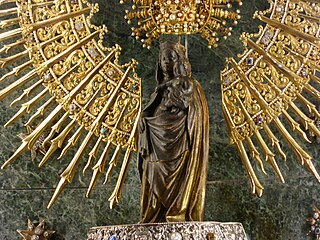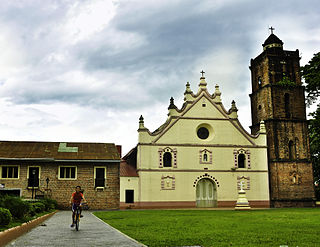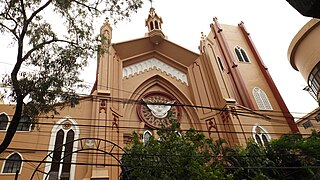
Our Lady of the Pillar is the name given to the Blessed Virgin Mary in the context of the traditional belief that Mary, while living in Jerusalem, supernaturally appeared to the Apostle James the Greater in AD 40 while he was preaching in what is now Spain. Those who adhere to this belief consider this appearance to be the only recorded instance of Mary exhibiting the mystical phenomenon of bilocation. Among Catholics, it is also considered the first Marian apparition, and unique because it happened while Mary was still living on Earth.

The Church of Saint Augustine, also known as the Archdiocesan Shrine of Our Lady of Consolation and Cincture or the Immaculate Conception Parish, is a Roman Catholic church under the auspices of the Order of Saint Augustine located inside the historic walled city of Intramuros in Manila, Philippines. Completed in 1607, it is the oldest stone church in the country.

Our Lady of China, the Great Mother, also known as Our Lady of Donglü, is a Roman Catholic title of the Blessed Virgin Mary and Child Jesus associated with a purported Marian apparition in Baoding, China in 1900.

Santa Cruz is a district in the northern part of the City of Manila, Philippines, located on the right bank of the Pasig River near its mouth, bordered by the districts of Tondo, Binondo, Quiapo, and Sampaloc, as well as the areas of Grace Park and Barrio San Jose in Caloocan and the district of La Loma in Quezon City. The district belongs to the 3rd congressional district of Manila.

The Minor Basilica and National Shrine of Jesus Nazareno (Black Nazarene), popularly known as Quiapo Church and canonically as the Saint John the Baptist Parish, is a prominent basilica in the district of Quiapo in the city of Manila, Philippines. It is the home of the Black Nazarene, a dark statue of Jesus Christ said to be miraculous. The basilica is under the jurisdiction of the Archdiocese of Manila under the Vicariate of José de Trozo and its current rector is Rufino C. Sescon, Jr.

The Immaculate Conception Cathedral of Pasig, commonly known as the Pasig Cathedral is a Roman Catholic church located in Plaza Rizal, Barangay Malinao, Pasig in Metro Manila, Philippines. It is the mother church, and the episcopal seat of the Diocese of Pasig and one of the oldest structures in the city.

The Metropolitan Cathedral of Saint Elizabeth of Hungary, also known as the National Shrine of Our Lady of the Candles and colloquially as Jaro Cathedral, is a cathedral located in the district of Jaro in Iloilo City, on the island of Panay in the Philippines. The seat of the Roman Catholic Archdiocese of Jaro, it was placed under the patronage of Saint Elizabeth of Hungary. It was established in 1575 as a visita (chapel-of-ease) of Oton by the Augustinians and as a separate parish in 1587. The present-day structure of Jaro Cathedral was built in 1874.

Binondo Church, formally known as the Minor Basilica and National Shrine of Saint Lorenzo Ruiz and also as Our Lady of the Most Holy Rosary Parish, is located in the district of Binondo, Manila fronting Plaza San Lorenzo Ruiz, in the Philippines. This church was founded by Dominican priests in 1596 to serve their Chinese converts to Christianity. The original building was destroyed in 1762 by British bombardment. A new granite church was completed on the same site in 1852 however it was greatly damaged during the Second World War, with only the western façade and the octagonal belfry surviving.

The San Fernando de Dilao Parish, also known as Paco Church, is a parish church located in the district of Paco in the city of Manila, Philippines, honoring the Castillian king saint Fernando III de Castilla y León. From February 7, 2012 to April 9, 2014, the parish was used as the pro-cathedral of Manila, during the structural renovations of the Manila Cathedral. The church inside is notable for its Romanesque-Byzantine interior with recently Italian Baroque styled altar, most notably the Latin inscriptions similar in style to Saint Peter's Basilica in Rome.

The Diocesan Shrine and Parish of Our Lady of Light, popularly known as Cainta Church, is a Roman Catholic parish church located along Andres Bonifacio Avenue in Barangay San Andres, Cainta, Rizal, in the Philippines. The church also operates a neighboring school, Cainta Catholic College. From its time of erection as a parish in 1760 until 1983, it belonged to the Archdiocese of Manila. It was placed under the newly created Diocese of Antipolo in 1983, which is now headed by Francisco M. De Leon. It belongs to the Vicariate of Our Lady of Light.

The National Shrine of Our Lady of the Abandoned, also known as the Santa Ana Church, is a Spanish colonial period church located in the district of Santa Ana in Manila, Philippines. The parish was established by the Franciscan missionaries in 1578 under the patronage of Saint Anne. The present stone church was constructed by Vicente Inglés from 1720 to 1725 and was dedicated to its present patron, the Our Lady of the Abandoned. The revered image of its patron was made in Valencia, Spain in 1713 and arrived in the Philippines in 1717.

Our Lady of Guadalupe Parish Church, designated as the Diocesan Shrine of Our Lady of Guadalupe of the Roman Catholic Diocese of San Pablo, is the only Roman Catholic church in Pagsanjan, Laguna, Philippines, and the oldest church in the Philippines under the patronage of Our Lady of Guadalupe. It is home to the patroness of Pagsanjan, Our Lady of Guadalupe, whose image was a gift from Mexico.

The Diocesan Shrine of the Our Lady of Candelaria Parish Church, commonly known as the Silang Church, is a Roman Catholic parish church in the municipality of Silang, in the province of Cavite, Philippines under the Roman Catholic Diocese of Imus. Its titular is the Our Lady of Candelaria. The church is known for its Spanish colonial architectural style and the rococo-influenced retablos. It is the oldest existing stone church in the province of Cavite having completed in 1639.

The Archdiocesan Shrine of Our Lady of Guidance, also known as Ermita Shrine or Ermita Church is a shrine located in the district of Ermita in the city of Manila, Philippines. The church is home to the Marian image of the Immaculate Concepcion known as Nuestra Señora de Guía, which is considered to be oldest in the Philippines, and in whose honor the church is officially named after and dedicated to.

The National Shrine and Parish of Saint Anne, commonly known as the Santa Ana Shrine or Hagonoy Church, is an 18th-century, Baroque Roman Catholic church located at Brgy. Santo Niño, Hagonoy, Bulacan, Philippines. The parish church, under the aegis of Saint Anne, is under the jurisdiction of the Roman Catholic Diocese of Malolos. It was declared a National Shrine in 1991. In 1981, a marker bearing a brief history of the church was installed on the church by the National Historical Institute, precursor of the National Historical Commission of the Philippines.

The San Juan Bautista Parish Church, commonly referred to as Jimenez Church, is a late-19th century, Baroque Roman Catholic church located at Brgy. Poblacion, Jimenez, Misamis Occidental, Philippines. The parish church, under the patronage of Saint John the Baptist, is under the jurisdiction of the Roman Catholic Archdiocese of Ozamiz. The church was declared a National Cultural Treasure of the Philippines in 2001.

The San Vicente Ferrer Parish Church, commonly referred to as Dupax Church or Dupax del Sur Church, is an 18th-century Baroque Roman Catholic church located at Brgy. Dopaj, Dupax del Sur, Nueva Vizcaya, Philippines. The parish church, under the advocation of Saint Vincent Ferrer, is under the jurisdiction of the Diocese of Bayombong. The church complex has been declared a National Cultural Treasure by the National Museum of the Philippines in July 2001.

The San Miguel Archangel Parish Church, commonly referred to as Orion Church, is a 16th-century, Baroque Roman Catholic church located at Brgy. San Vicente, Orion, Bataan, Philippines. The parish church, dedicated to Saint Michael, the Archangel, is under the jurisdiction of the Roman Catholic Diocese of Balanga. A marker bearing the brief history of the structure has been installed in its façade by the National Historical Committee, precursor of the National Historical Commission of the Philippines. The current priest of the parish church is Fr. Abraham SP. Pantig.

Espiritu Santo Parish, now known as the Archdiocesan Shrine of Espiritu Santo, is a Roman Catholic parish church belonging to the Archdiocese of Manila that is located at 1912 Rizal Avenue corner Tayuman Street, Santa Cruz, Manila, Philippines. It was declared an Archdiocesan Shrine by Cardinal Luis Antonio G. Tagle, Archbishop Emeritus of Manila, on June 8, 2014, the Solemnity of the Pentecost. Eymard Dennis Peter Marcelino S. Odiver is the current parish priest and rector of the church since 2022.




























